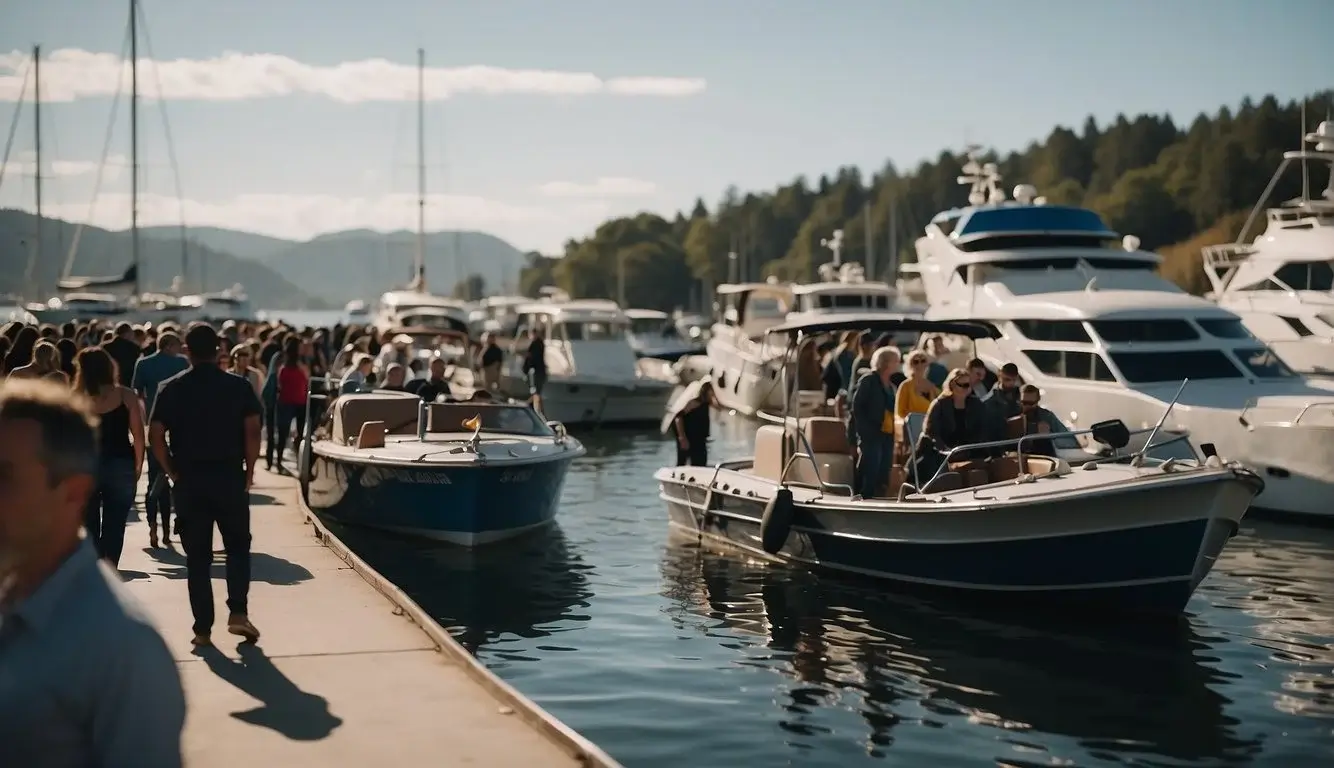Becoming proficient in utilizing boat ramps entails not just simple skill but also embodies both courtesy and productivity. Through my time spent on the water, I’ve realized following proper procedures at boat ramps is crucial for a smooth boating day. It’s not just about launching and getting your boat out of the water; it involves cooperating with fellow boaters to ensure everyone has an enjoyable time.
My top tips for boat ramp use are being prepared before reaching the ramp, moving quickly but safely, and always being mindful of others. These practices not only make the process smoother for me but also for everyone waiting their turn. Good boat ramp etiquette combines preparedness, speed, and respect, setting the tone for a great day on the water.
- Being prepared before reaching the ramp leads to a smoother launch.
- Efficiency and speed on the ramp help maintain a good flow for all users.
- Respect for others’ time and space ensures a friendly boating community.
Understanding Boat Ramp Etiquette
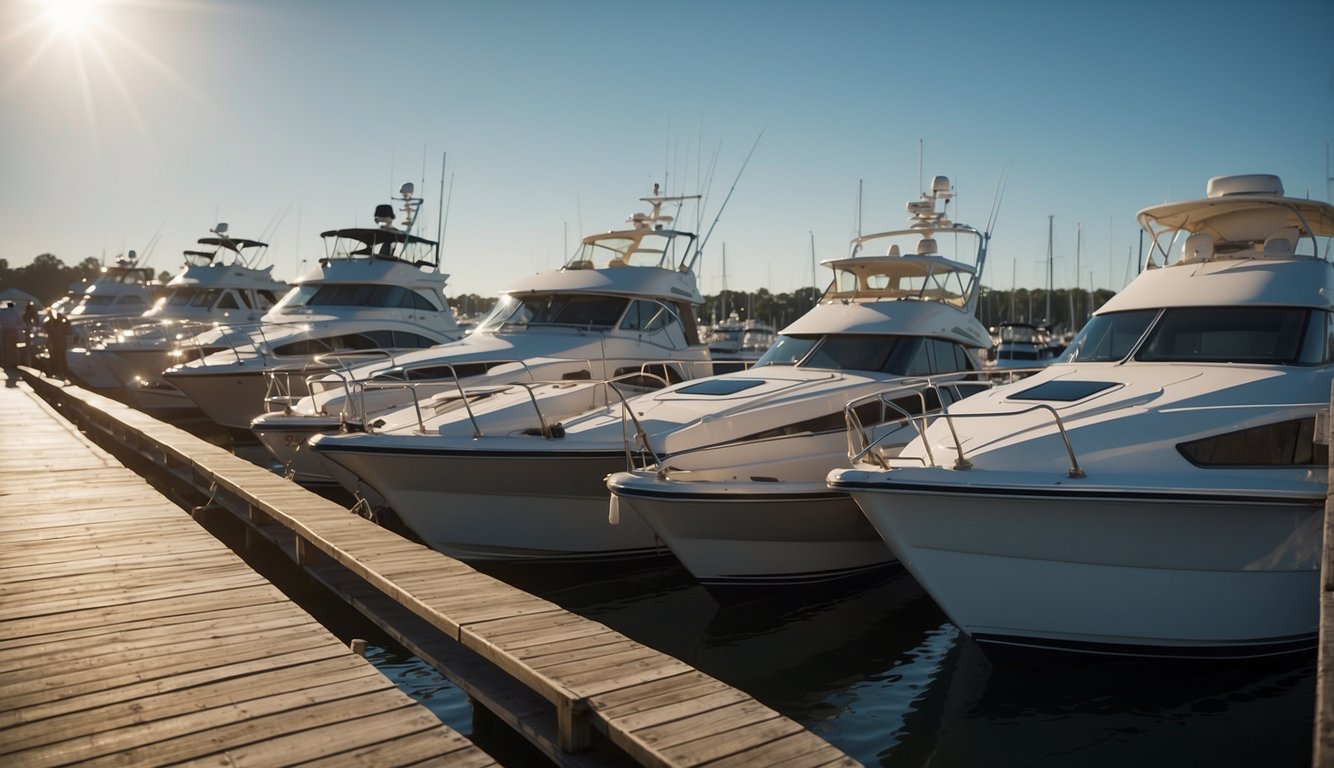
Boat ramp etiquette is essential for a smooth and enjoyable experience at the water’s edge. I’ll guide you through the importance of these protocols and some specific rules to follow.
Importance of Ramp Etiquette
Boat ramp etiquette is more than just common courtesy; it’s a practical approach to effectively using shared spaces. When I consider the etiquette at the boat ramp, I think about safety, efficiency, and the impact my actions have on others. For instance, being well-prepared and speedy in my launch prevents queues and reduces stress for everyone.
Basic Etiquette Rules
- Preparation: I ensure my boat is ready for launch before reaching the ramp. This means having my gear stowed, lines ready, and the drain plug in place. Sticking to these steps avoids hold-ups and keeps things moving for others waiting to use the ramp.
- Efficiency at the Ramp: I move purposefully when it’s my turn, understanding that speed and competency keep the ramp clear for the next person. This involves having someone experienced to guide my trailer if needed, or if I’m alone, using signals to ensure I’m correctly aligned.
- Post-Launch Protocol: After launching my boat, I promptly move my vehicle and trailer to the designated parking area. It’s important to clear the ramp quickly for the next boater.
- General Courtesy: I always offer a helping hand when I see someone in need, and if I’m unsure about something, I’m not hesitant to ask for advice. After all, a friendly atmosphere makes the boating community stronger.
Maintaining decorum at the boat ramp, ensuring order over chaos, is a responsibility that falls on all boaters. It keeps our shared spaces safe, enjoyable, and accessible for all users.
Preparing Your Boat
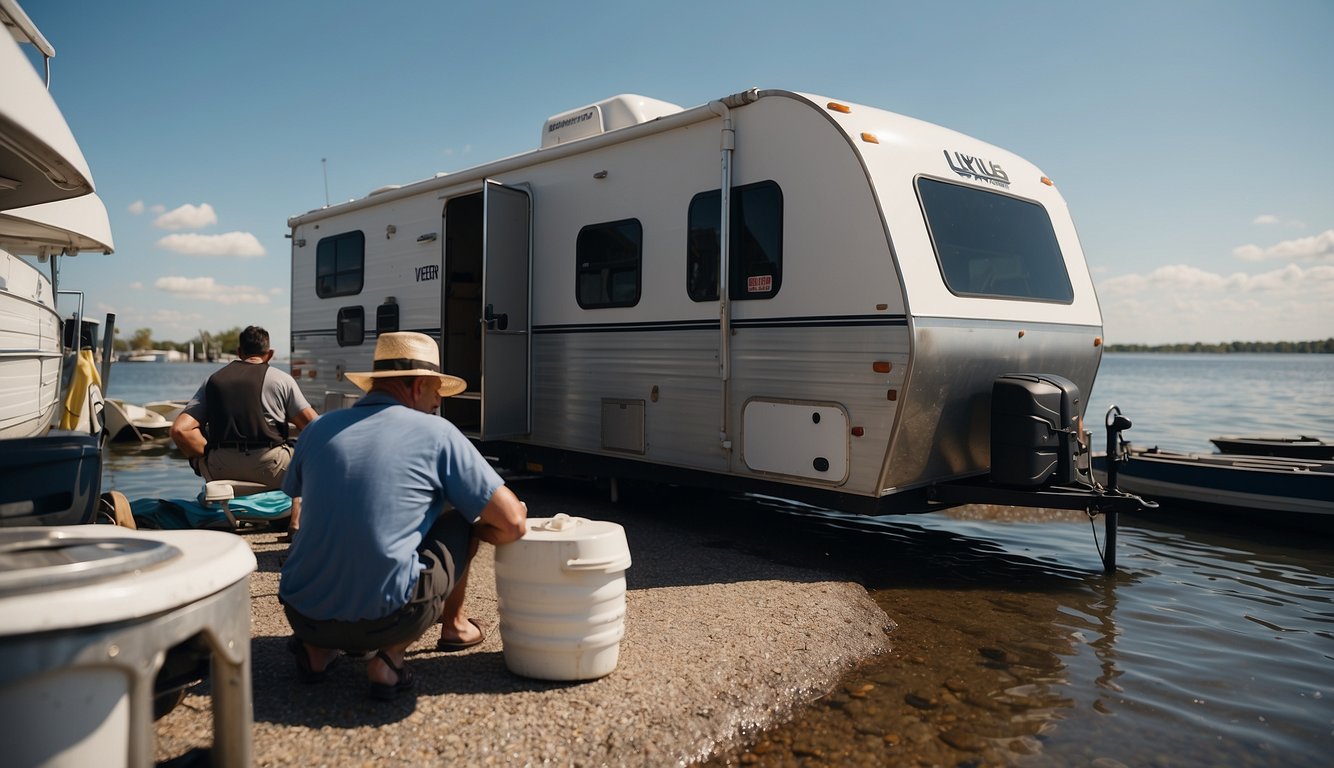
Prep Work Before Arrival
I begin my preparation long before reaching the boat ramp. At home, I ensure my trailer is correctly attached to my vehicle with the safety chain secure and trailer lights functioning. I check that the tie-downs are tightly fastened and double-check the drain plug is in place.
- Checklist:
- Trailer attached and safety chain secured
- Trailer lights operational
- Tie-downs and transom tie-down straps secure
- Drain plug inserted
Checking Your Boat and Gear
Once I’m confident the trailer is road-ready, I inspect my boat and gear. The engine, especially if it’s an outboard motor, must be supported with an outboard motor brace to prevent damage during transport. I also ensure my gear is stowed properly and navigation lights are working if I plan to be out from dusk till dawn.
- Inspection Points:
- Outboard motor brace in place
- Gear stowed and secured
- Navigation lights functional
By handling these tasks ahead of time, I’m setting myself up for a hassle-free launch once I reach the boat ramp.
Using the Staging Area
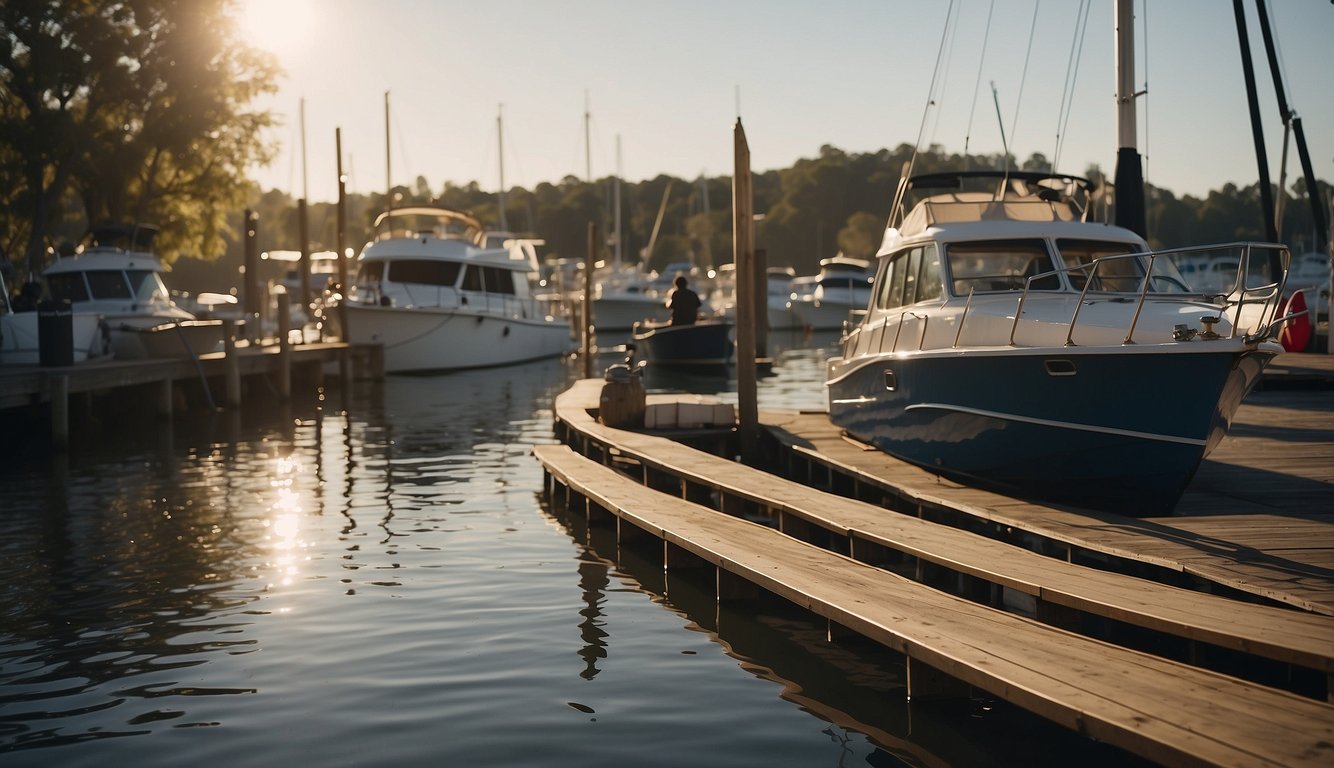
Before I approach the boat ramp, I make sure everything is set for a smooth launch in the staging area. It’s about preparation and respect for others waiting their turn.
Staging Your Boat
In the staging area, I take my time to carefully prepare my boat for launch. Here’s my checklist:
- Safety Gear: I ensure my life jackets, fire extinguishers, and other safety equipment are aboard.
- Boat Plug: It must be in place before I approach the water.
- Cover and Tie-downs: I remove the boat cover and stow all tie-down straps.
Final Pre-Launch Checks
Once the preparation is done, there are just a few things left for me:
- Engine Check: I always start my engine to make sure it’s running smoothly before launch.
- Final Inspection: A quick once-over to ensure nothing is missed.
This careful preparation in the staging area ensures I don’t hold up the line at the ramp and that my time on the water is safe and enjoyable.
Launching Your Boat

When I approach the boat launch, my goal is always to get my boat into the water smoothly and swiftly. Efficiency and clear communication between me and my spotter are paramount to avoid holdups.
Efficient Launch Techniques
Before I even get to the ramp, I ensure all my preparations are done ahead of time. This includes removing tie-downs, loading gear, and installing drain plugs. When it’s my turn, I back up the trailer in a controlled manner, aligning it with the water’s edge. I keep my movements smooth to avoid sharp jerks that could disrupt the boat’s position on the trailer.
Once I’m at the water’s edge, my primary focus is on a swift transition. My boat’s engine is off while the boat is on the trailer, and I only start it once the boat is in the water. If I’m launching solo, I use a rope to guide the boat off the trailer from a safe distance. When it’s in the water, I promptly move my vehicle and trailer to the designated parking area to make way for fellow boaters.
Driver and Spotter Communication
I find that using hand signals is a clear and effective way for my spotter and me to communicate, especially when engine noise and distance make verbal communication difficult. My spotter helps guide me as I reverse the trailer by indicating direction and distance. Once we’re aligned, they signal me to stop, and I back the trailer into the water.
My boat driver responsibilities don’t end once the boat is in the water. I make sure the engine is functioning correctly before fully disengaging from the trailer. It’s a team effort; my spotter then hops on, and I navigate us away from the ramp calmly and considerately, checking that all systems are go before we set off for our adventure.
Post-Launch Procedures

Once my boat slides off the trailer and into the water, my attention immediately turns to clearing the ramp area efficiently and securing my boat at the courtesy dock. These actions are critical to avoid creating a bottleneck at the ramp and to practice good boat ramp etiquette.
Clearing the Ramp Area
As soon as my boat is afloat, I ensure that I remove all the necessary straps and transom tie-downs before I start the launch. To prevent delays for others waiting to use the boat ramp, I quickly drive my vehicle and trailer away from the ramp. It’s important that I do this promptly and efficiently to keep the area clear for the next person.
Moving to the Courtesy Dock
After launching, I immediately move my boat to the courtesy dock. I make sure I have my dock lines ready, so I can tie up my boat as soon as I reach the dock. This allows others to use the boat ramp while I finish loading any remaining gear into my boat. It’s also a good opportunity to double-check that my drain plug is secure, and my boat is ready for a day on the water. Remember, a smooth transition at the dock keeps everyone happy and the flow of boats steady.
Retrieving Your Boat

When I retrieve my boat, I know it’s crucial to be efficient and considerate to ensure the process goes smoothly for both me and fellow boaters at the ramp.
Safe Retrieval Practices
First, I make sure my tow vehicle is prepared before I start the retrieval process. Here’s a checklist that I always follow:
- Safety Check: Verify that the safety chain and trailer lights are in working order.
- Positioning: Align my trailer correctly on the boat ramp for the easiest access.
- Backing Down: Slowly back the trailer into the water, ensuring it’s not too deep, which could damage the vehicle.
When my boat approaches the trailer, I cut the propeller to avoid any accidents. Slowly, I’ll guide the boat onto the trailer, making sure it’s centered.
Re-Loading and Securing the Boat
Once the boat is on the trailer, I proceed with these steps:
- Pull up: Move away from the ramp to a designated area for final preparations.
- Securing:
- Attach transom straps to secure the boat’s stern.
- Ensure tie-downs are snug and secure.
Note: Always double-check that the safety chain is connected once the boat is on the trailer to prevent it from sliding off during transport.
By following these specific steps, I ensure a safe and courteous retrieval of my boat, which keeps me and others safe and happy at the boat ramp.
Parking and Trailering
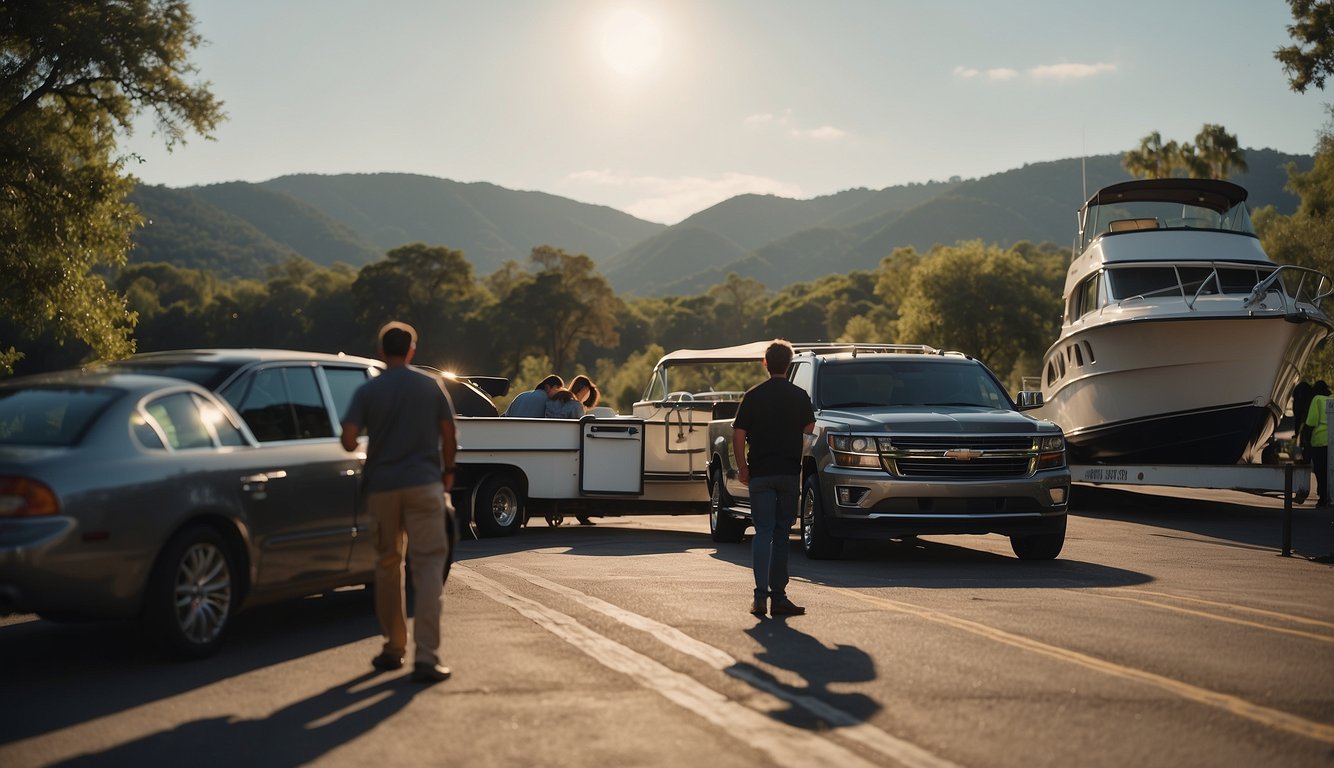
Before we dive right into the water, it’s my duty to ensure that my vehicle and trailer are handled correctly in the parking lot. Both parking and trailering are crucial for a smooth start to any boating adventure.
Proper Parking Lot Etiquette
When I arrive at the parking lot, my first priority is to find a spot that’s convenient for both myself and other boaters. I always make sure to park my tow vehicle and trailer neatly within the lines. Here’s what I keep in mind:
- Space use: Occupy only the amount of space necessary for my vehicle and trailer.
- Proximity: I park close enough to the launch to minimize inconvenience but far enough away to avoid congestion.
- Courtesy: If I notice a fellow boater having trouble, I offer to help them maneuver their trailer or provide guidance.
Do:
- Use designated spaces for trailering.
- Park in a straight line.
Don’t:
- Block other vehicles.
- Take up more space than necessary.
Trailering Tips
Handling a trailer can be intimidating, but with a few tried-and-true tips, I’ve mastered the art of trailering smoothly:
- Pre-launch check: Before I leave home, I make sure that all the lights on my trailer are working and that the boat is secured with the proper straps.
- Driving: I allow for extra stopping distance and wider turns to account for the added length and weight of the trailer.
Remember:
- Drive slowly to keep control of the trailer.
- Double-check that the trailer’s connections to the tow vehicle are secure.
At the ramp:
- Back the trailer down the ramp slowly.
- Maintain a straight line to avoid jackknifing.
Using these guidelines, I help ensure a respectful and efficient experience at the boat ramp for everyone involved.
Environmental Considerations

When I boat, I’m always conscious of my environmental impact. It’s crucial for me, and all boaters, to take steps to preserve our waterways. Two key areas I focus on are preventing the spread of invasive species and adhering to the Clean, Drain, Dry initiative.
Preventing Invasive Species
My first priority at the boat ramp is to stop the spread of invasive species. These non-native plants, animals, and microorganisms can wreak havoc on ecosystems if they hitch a ride on my boat or gear. Before launching and after retrieving my boat, I thoroughly inspect it, the trailer, and all my equipment to ensure no unwanted guests are tagging along. It’s a simple habit that can make a big difference.
Clean, Drain, Dry Initiative
Next, I stick to the Clean, Drain, Dry protocol every time my boat leaves a body of water. Here’s what I do:
- Clean: I remove any visible mud, plants, fish, or animals from the boat, trailer, and gear.
- Drain: I drain all water from the boat, including the bilge, live wells, and bait wells, before leaving the area.
- Dry: I allow my boat and all equipment to dry completely or, if that’s not possible, I use a disinfectant to clean everything thoroughly.
By doing this, I’m doing my part to protect water resources and keep the ecosystems healthy.
Handling Conflicts

In my time at the boat ramp, I’ve seen my fair share of conflicts. It’s essential to address them with poise to ensure everyone can continue to enjoy their time on the water.
Dealing with Discourteous Boaters
When I encounter discourteous boaters, my first step is always to communicate clearly and calmly. I find that sometimes people are unaware of their behavior and how it impacts others. I’ll say something like, “Excuse me, I noticed you skipped the queue. We’re all eager to get on the water, could you please respect the order?” This direct approach often reminds others of the importance of following boat ramp etiquette without escalating tensions.
- Speak Up: If someone is being particularly annoying, I don’t hesitate to speak up, but I keep my tone polite and my words non-confrontational.
- Rule Reminder: A gentle reminder about the etiquette, possibly informed by guides like Boat Ramp Etiquette: All The Dos & Don’ts Explained for Beginners, can encourage better behavior.
Maintaining Composure
It’s easy for egos to get in the way and bruised feelings to surface in these scenarios. I make it a priority to maintain my composure, reminding myself that I’m here to have fun on the water, not to let minor inconveniences ruin my day. When I feel my frustration rising, I take a deep breath and count to ten—this simple act of mindfulness helps me respond thoughtfully instead of reacting impulsively.
- Deep Breaths: I focus on keeping calm; this encourages others to do the same.
- Positive Focus: Shifting attention to the enjoyable parts of boating can diffuse tension and redirect energy away from conflicts.
Extra Tips and Considerations

Before we dive into the details, it’s essential for me to pack smart and communicate effectively to ensure a smooth boat launching experience. A well-stocked boat and clear communication can make all the difference between a day of fun or frustration at the boat ramp.
Packing Essential Items
I always start by securing my coolers, fishing tackle, wakeboards, and skis. It’s crucial to check that my boat’s battery and ignition are functioning correctly to avoid hold-ups when it’s my turn to launch.
- Coolers: Ensure they’re well-stocked and accessible.
- Fenders: Attach these to the docking side of my boat to protect it.
- Motor: Confirm that my motor is free of transom tie-downs and ready to go.
- Safety Equipment: Visibly laying out life jackets and fire extinguishers is smart and necessary for a quick inspection.
Remembering local regulations, I ensure all necessary items are unloaded and parked vehicles are clear of the ramp.
Mindful Communication
At the helm, clear communication with my friends or other boaters is key. A simple chat can help coordinate efforts and keep the atmosphere accommodating. For example, I’ll signal when I’m about to power load my boat to avoid any confusion or mishaps.
- Boating etiquette: A friendly “hello” or asking if someone needs a hand goes a long way.
- Pay station: If there’s a queue, I discuss with others to determine who is ready to launch or pay next.
Understanding and using resources like the Mercury Quick Tip can offer additional guidance on boat ramp etiquette. Always be ready to assist or make room for others when needed; it’s part of my responsibility as a boat owner.
FAQ – Boat Ramp Etiquette
What is the proper procedure for launching a boat at a ramp?
Prepare your boat for launch away from the ramp in a designated staging area. Once it’s your turn, quickly and efficiently move your boat into the water, then immediately clear the ramp area for others.
How can I avoid causing delays at the boat ramp?
Have your boat and gear ready before you get to the ramp, and once launched, move your vehicle and trailer to the parking area promptly to avoid blocking others
Is it acceptable to park on the boat ramp while preparing or securing my boat?
No, you should use the staging area for any preparation or securing of your boat to avoid blocking the ramp
If you enjoyed reading about Boat Ramp Etiquette, check out our other articles:
- Bowling Etiquette 2024: Tips for Polite Play on the Lanes
- Surf Etiquette 2024: Key Rules for Sharing the Waves
- Tennis Etiquette 2024: Key Rules and Polite Play for Beginners
- Laundromat Etiquette 2024: Tips for a Harmonious Wash Day
Feel free to also check out our other Articles from the category “Etiquette & Manners“ and don’t forget to follow us on Pinterest.

